Windows10+Python3下安装NumPy+SciPy+Matplotlib
Posted
tags:
篇首语:本文由小常识网(cha138.com)小编为大家整理,主要介绍了Windows10+Python3下安装NumPy+SciPy+Matplotlib相关的知识,希望对你有一定的参考价值。
Numpy、SciPy、MatplotLib是Python下从事科学计算必不可少的库。我在用其他的方法安装时出现各种问题,发现直接安装.whl包是最快且不报错的方法。
1.下载.whl包
在下面的网站中找需要的.whl文件下载
http://www.lfd.uci.edu/~gohlke/pythonlibs/
要和自己本地安装的版本一致,我选择的whl文件是:
numpy-1.13.0+mkl-cp36-cp36m-win32.whl
scipy-0.19.1-cp36-cp36m-win32.whl
matplotlib-2.0.2-cp36-cp36m-win32.whl
2.开始在命令行安装
>pip3 install c:\\(whl文件下载的路径)\\numpy-1.13.0+mkl-cp36-cp36m-win32.whl
>pip3 install c:\\(whl文件下载的路径)\\scipy-0.19.1-cp36-cp36m-win32.whl
>pip3 install c:\\(whl文件下载的路径)\\matplotlib-2.0.2-cp36-cp36m-win32.whl
如果不出意外,这就都安装好了。
3.开始测试
测试代码来自:http://www.cnblogs.com/jasonfreak/p/5441512.html 感谢作者
1 from numpy import array 2 from numpy.random import normal 3 from matplotlib import pyplot 4 5 def genData(): 6 heights = [] 7 weights = [] 8 grades = [] 9 N = 10000 10 11 for i in range(N): 12 while True: 13 # 身高服从均值172,标准差为6的正态分布 14 height = normal(172, 6) 15 if 0 < height: break 16 while True: 17 # 体重由身高作为自变量的线性回归模型产生,误差服从标准正态分布 18 weight = (height - 80) * 0.7 + normal(0, 1) 19 if 0 < weight: break 20 while True: 21 # 分数服从均值为70,标准差为15的正态分布 22 score = normal(70, 15) 23 if 0 <= score and score <= 100: 24 grade = ‘E‘ if score < 60 else ( 25 ‘D‘ if score < 70 else (‘C‘ if score < 80 else (‘B‘ if score < 90 else ‘A‘))) 26 break 27 heights.append(height) 28 weights.append(weight) 29 grades.append(grade) 30 return array(heights), array(weights), array(grades) 31 32 33 # 绘制柱状图 34 def drawBar(grades): 35 xticks = [‘A‘, ‘B‘, ‘C‘, ‘D‘, ‘E‘] 36 gradeGroup = {} 37 # 对每一类成绩进行频数统计 38 for grade in grades: 39 gradeGroup[grade] = gradeGroup.get(grade, 0) + 1 40 # 创建柱状图 41 # 第一个参数为柱的横坐标 42 # 第二个参数为柱的高度 43 # 参数align为柱的对齐方式,以第一个参数为参考标准 44 pyplot.bar(range(5), [gradeGroup.get(xtick, 0) for xtick in xticks], align=‘center‘) 45 46 # 设置柱的文字说明 47 # 第一个参数为文字说明的横坐标 48 # 第二个参数为文字说明的内容 49 pyplot.xticks(range(5), xticks) 50 51 # 设置横坐标的文字说明 52 pyplot.xlabel(‘Grade‘) 53 # 设置纵坐标的文字说明 54 pyplot.ylabel(‘Frequency‘) 55 # 设置标题 56 pyplot.title(‘Grades Of Male Students‘) 57 # 绘图 58 pyplot.show() 59 60 61 #绘制饼形图 62 def drawPie(grades): 63 labels = [‘A‘, ‘B‘, ‘C‘, ‘D‘, ‘E‘] 64 gradeGroup = {} 65 for grade in grades: 66 gradeGroup[grade] = gradeGroup.get(grade, 0) + 1 67 #创建饼形图 68 #第一个参数为扇形的面积 69 #labels参数为扇形的说明文字 70 #autopct参数为扇形占比的显示格式 71 pyplot.pie([gradeGroup.get(label, 0) for label in labels], labels=labels, autopct=‘%1.1f%%‘) 72 pyplot.title(‘Grades Of Male Students‘) 73 pyplot.show() 74 75 76 #绘制直方图 77 def drawHist(heights): 78 #创建直方图 79 #第一个参数为待绘制的定量数据,不同于定性数据,这里并没有事先进行频数统计 80 #第二个参数为划分的区间个数 81 pyplot.hist(heights, 100) 82 pyplot.xlabel(‘Heights‘) 83 pyplot.ylabel(‘Frequency‘) 84 pyplot.title(‘Heights Of Male Students‘) 85 pyplot.show() 86 87 88 #绘制累积曲线 89 def drawCumulativeHist(heights): 90 #创建累积曲线 91 #第一个参数为待绘制的定量数据 92 #第二个参数为划分的区间个数 93 #normed参数为是否无量纲化 94 #histtype参数为‘step‘,绘制阶梯状的曲线 95 #cumulative参数为是否累积 96 pyplot.hist(heights, 20, normed=True, histtype=‘step‘, cumulative=True) 97 pyplot.xlabel(‘Heights‘) 98 pyplot.ylabel(‘Frequency‘) 99 pyplot.title(‘Heights Of Male Students‘) 100 pyplot.show() 101 102 103 #绘制散点图 104 def drawScatter(heights, weights): 105 #创建散点图 106 #第一个参数为点的横坐标 107 #第二个参数为点的纵坐标 108 pyplot.scatter(heights, weights) 109 pyplot.xlabel(‘Heights‘) 110 pyplot.ylabel(‘Weights‘) 111 pyplot.title(‘Heights & Weights Of Male Students‘) 112 pyplot.show() 113 114 115 #绘制箱形图 116 def drawBox(heights): 117 #创建箱形图 118 #第一个参数为待绘制的定量数据 119 #第二个参数为数据的文字说明 120 pyplot.boxplot([heights], labels=[‘Heights‘]) 121 pyplot.title(‘Heights Of Male Students‘) 122 pyplot.show() 123 124 data = genData() 125 print(data) 126 heights = data[0] 127 weights = data[1] 128 grades = data[2] 129 drawBar(grades) 130 drawPie(grades) 131 drawHist(heights) 132 drawCumulativeHist(heights) 133 drawScatter(heights, weights) 134 drawBox(heights)
运行结果:
drawBar(grades)
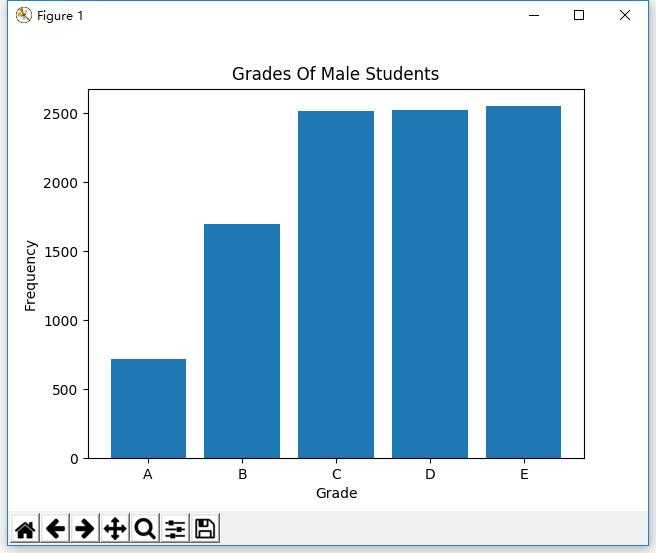
drawPie(grades)
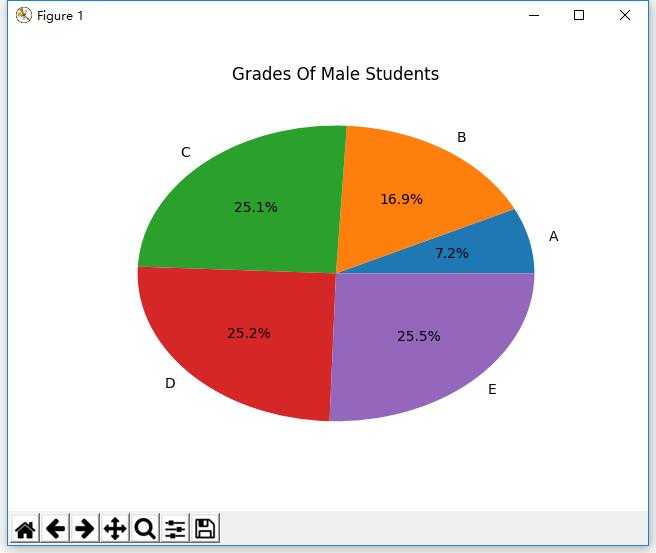
drawHist(heights)
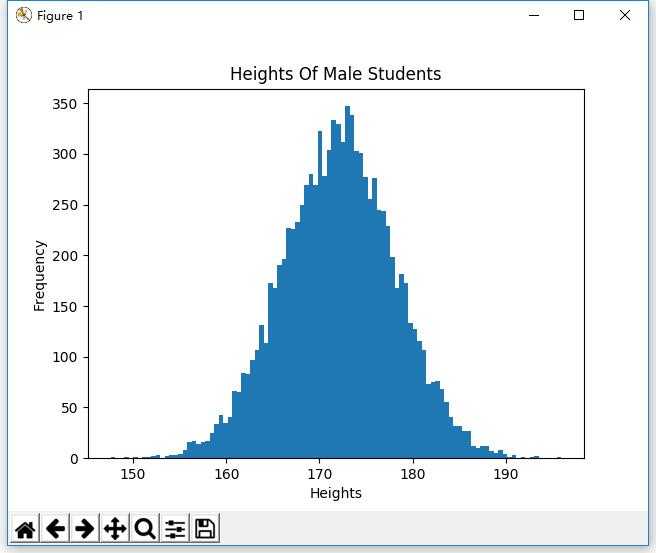
drawCumulativeHist(heights)
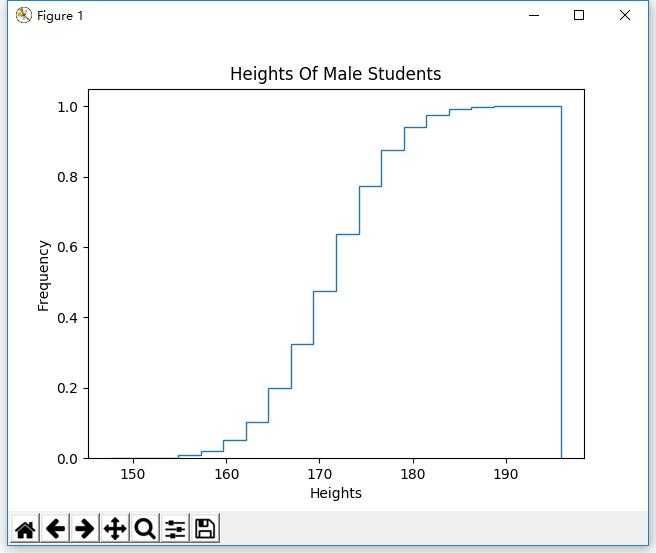
drawScatter(heights, weights)
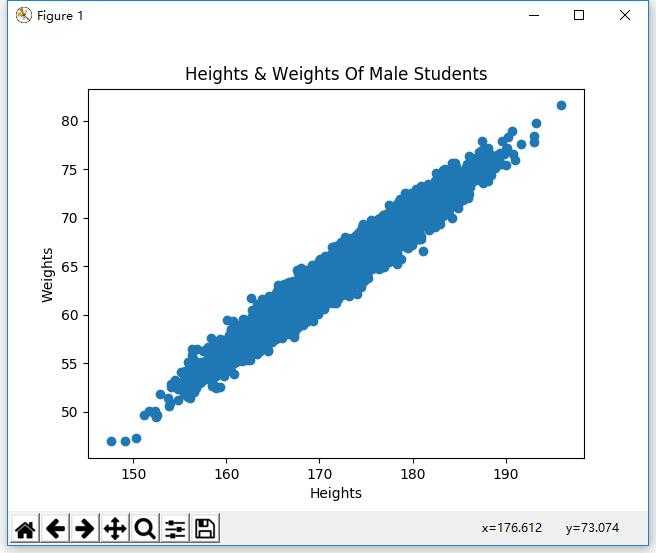
drawBox(heights)
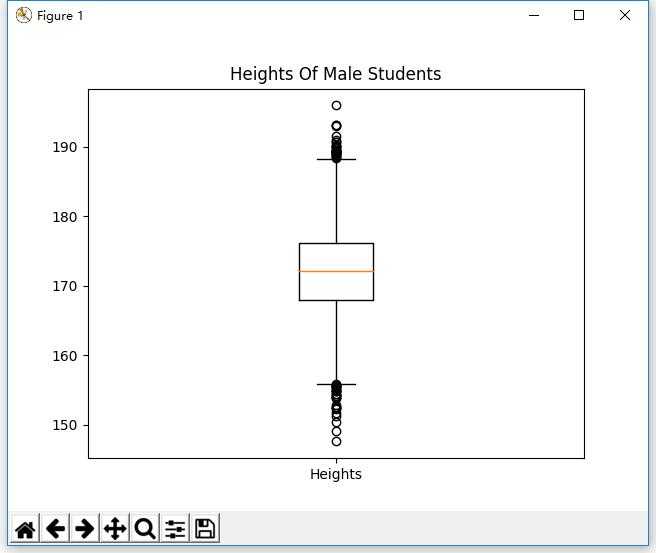
成功!
以上是关于Windows10+Python3下安装NumPy+SciPy+Matplotlib的主要内容,如果未能解决你的问题,请参考以下文章